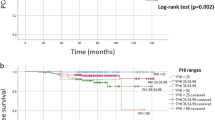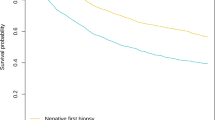Abstract
Background:
To evaluate whether the extent of baseline acute prostate inflammation (API) and chronic prostate inflammation (CPI) was associated with risk of prostate cancer (PCa) at 2-year repeat prostate biopsy in a clinical trial with systematic biopsies independent of PSA.
Methods:
A retrospective analysis of 6065 men with a negative baseline biopsy in the reduction by dutasteride of PCa events (REDUCE) trial undergoing 2-year biopsy. API and CPI extent (percentage of cores involved) and PCa (present or absent) were assessed by central pathology. The association of baseline API and CPI with PCa at the 2-year biopsy was evaluated with logistic regression in uni- and multivariable analyses.
Results:
API extent was classified as absent or involving 1–25%, 26–50%, 51–75% and >75% cores in 5140 (85%), 742 (12%), 151 (2%), 17 (<1%) and 15 (<1%) cases, respectively. CPI extent was classified as absent or involving 1–25%, 26–50%, 51–75% and >75% cores in 1367 (22%), 2532 (42%), 1474 (24%), 397 (7%) and 295 (5%) cases, respectively. More extensive API was associated with younger age, lower PSA and lower prostate volume, while more extensive CPI was associated with older age, lower PSA and higher prostate volume (all P<0.01). In both uni- and multivariable analyses, API and CPI extent were associated with lower risk of PCa at the 2-year biopsy (both P<0.01).
Conclusions:
In a cohort of men undergoing repeat prostate biopsy 2 years after a negative baseline biopsy, a greater extent of baseline API and CPI was independently associated with lower PCa risk.
This is a preview of subscription content, access via your institution
Access options
Subscribe to this journal
Receive 4 print issues and online access
$259.00 per year
only $64.75 per issue
Buy this article
- Purchase on Springer Link
- Instant access to full article PDF
Prices may be subject to local taxes which are calculated during checkout
Similar content being viewed by others
References
Pepe P, Aragona F . Does an inflammatory pattern at primary biopsy suggest a lower risk for prostate cancer at repeated saturation prostate biopsy? Urol Int 2011; 87: 171–174.
Gui-Zhong L, Libo M, Guanglin H, Jianwei W . The correlation of extent and grade of inflammation with serum PSA levels in patients with IV prostatitis. Int Urol Nephrol 2011; 43: 295–301.
Sfanos KS, De Marzo AM . Prostate cancer and inflammation: the evidence. Histopathology 2012; 60: 199–215.
Schatteman PH, Hoekx L, Wyndaele JJ, Jeuris W, Van Marck E . Inflammation in prostate biopsies of men without prostatic malignancy or clinical prostatitis: correlation with total serum PSA and PSA density. Eur Urol 2000; 37: 404–412.
Rosenblatt KA, Wicklund KG, Stanford JL . Sexual factors and the risk of prostate cancer. Am J Epidemiol 2001; 153: 1152–1158.
Sarma AV, McLaughlin JC, Wallner LP, Dunn RL, Cooney KA, Schottenfeld D et al. Sexual behavior, sexually transmitted diseases and prostatitis: the risk of prostate cancer in black men. J Urol 2006; 176: 1108–1113.
Dennis LK, Lynch CF, Torner JC . Epidemiologic association between prostatitis and prostate cancer. Urology 2002; 60: 78–83.
Cheng I, Witte JS, Jacobsen SJ, Haque R, Quinn VP, Quesenberry CP et al. Prostatitis, sexually transmitted diseases, and prostate cancer: the California Men's Health Study. PLoS One 2010; 5: e8736.
Yli-Hemminki TH, Laurila M, Auvinen A, Maattanen L, Huhtala H, Tammela TL et al. Histological inflammation and risk of subsequent prostate cancer among men with initially elevated serum prostate-specific antigen (PSA) concentration in the Finnish prostate cancer screening trial. BJU Int 2013; 112: 735–741.
Gann PH, Fought A, Deaton R, Catalona WJ, Vonesh E . Risk factors for prostate cancer detection after a negative biopsy: a novel multivariable longitudinal approach. J Clin Oncol 2010; 28: 1714–1720.
Fujita K, Hosomi M, Tanigawa G, Okumi M, Fushimi H, Yamaguchi S . Prostatic inflammation detected in initial biopsy specimens and urinary pyuria are predictors of negative repeat prostate biopsy. J Urol 2011; 185: 1722–1727.
Kryvenko ON, Jankowski M, Chitale DA, Tang D, Rundle A, Trudeau S et al. Inflammation and preneoplastic lesions in benign prostate as risk factors for prostate cancer. Mod Pathol 2012; 25: 1023–1032.
Moreira DM, Nickel JC, Gerber L, Muller RL, Andriole GL, Castro-Santamaria R et al. Baseline prostate inflammation is associated with a reduced risk of prostate cancer in men undergoing repeat prostate biopsy: Results from the REDUCE study. Cancer 2013; 121: 4271.
Yaman O, Gogus C, Tulunay O, Tokatli Z, Ozden E . Increased prostate-specific antigen in subclinical prostatitis: the role of aggressiveness and extension of inflammation. Urol Int 2003; 71: 160–164.
Andriole GL, Bostwick DG, Brawley OW, Gomella LG, Marberger M, Montorsi F et al. Effect of dutasteride on the risk of prostate cancer. N Engl J Med 2010; 362: 1192–1202.
Andriole GL, Kirby R . Safety and tolerability of the dual 5alpha-reductase inhibitor dutasteride in the treatment of benign prostatic hyperplasia. Eur Urol 2003; 44: 82–88.
Nickel JC, Roehrborn CG, O'Leary MP, Bostwick DG, Somerville MC, Rittmaster RS . Examination of the relationship between symptoms of prostatitis and histological inflammation: baseline data from the REDUCE chemoprevention trial. J Urol 2007; 178: 896–900.
Wu C, Moreira DM, Gerber L, Rittmaster RS, Andriole GL, Freedland SJ . Diabetes and prostate cancer risk in the REDUCE trial. Prostate Cancer Prostatic Dis 2011; 14: 326–331.
Kandirali E, Boran C, Serin E, Semercioz A, Metin A . Association of extent and aggressiveness of inflammation with serum PSA levels and PSA density in asymptomatic patients. Urology 2007; 70: 743–747.
Berney DM, Algaba F, Camparo P, Comperat E, Griffiths D, Kristiansen G et al. Variation in reporting of cancer extent and benign histology in prostate biopsies among European pathologists. Virchows Arch 2014; 464: 583–587.
Simardi LH, Tobias-MacHado M, Kappaz GT, Taschner Goldenstein P, Potts JM, Wroclawski ER . Influence of asymptomatic histologic prostatitis on serum prostate-specific antigen: a prospective study. Urology 2004; 64: 1098–1101.
Di Silverio F, Gentile V, De Matteis A, Mariotti G, Giuseppe V, Luigi PA et al. Distribution of inflammation, pre-malignant lesions, incidental carcinoma in histologically confirmed benign prostatic hyperplasia: a retrospective analysis. Eur Urol 2003; 43: 164–175.
Author information
Authors and Affiliations
Corresponding author
Ethics declarations
Competing interests
RC-S is employed by GlaxoSmithKline. SJF has received a grant from GlaxoSmithKline. JCN has acted as a consultant for GlaxoSmithKline, Pfizer, Astellas and Lilly. He has provided expert testimony for GlaxoSmithKline and has received a grant from the company for the BPH Prostatitis Investigator-Initiated Study. GLA has received a grant from GlaxoSmithKline as well as a consulting fee for acting as chair of the REDUCE Steering Committee. He has also acted as a consultant for Bayer, Genomic Health, GlaxoSmithKline and Myriad Genetics. DMM declares no conflict of interest.
Additional information
Supplementary Information accompanies the paper on the Prostate Cancer and Prostatic Diseases website
Supplementary information
Rights and permissions
About this article
Cite this article
Moreira, D., Nickel, J., Andriole, G. et al. Greater extent of prostate inflammation in negative biopsies is associated with lower risk of prostate cancer on repeat biopsy: results from the REDUCE study. Prostate Cancer Prostatic Dis 19, 180–184 (2016). https://doi.org/10.1038/pcan.2015.66
Received:
Revised:
Accepted:
Published:
Issue Date:
DOI: https://doi.org/10.1038/pcan.2015.66
This article is cited by
-
The combination of histological prostate atrophy and inflammation is associated with lower risk of prostate cancer in biopsy specimens
Prostate Cancer and Prostatic Diseases (2017)



